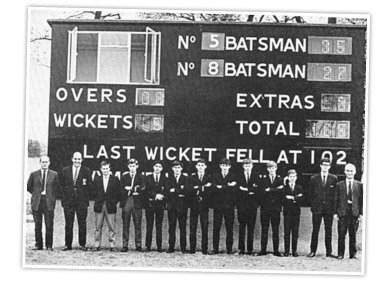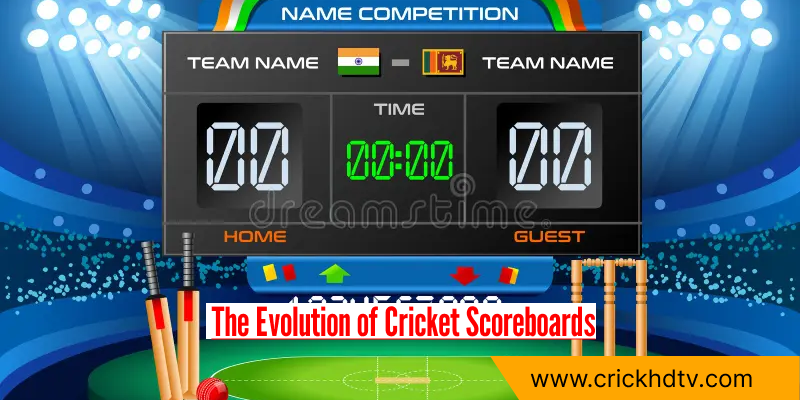The Evolution of Cricket Scoreboards: Cricket, one of the most traditionally and historically rich sports, has undergone many changes over the centuries. Among many changes, cricket scoreboards have reached a dimension in terms of their dynamic growth. From the earlier humble, handwritten tallies to the ultra-modern digital displays, Cricket Scoreboards of today’s stadiums have evolved to meet the modern demands of cricket fans, players, and broadcasters.
Early Days: The Handwritten Era
Cricket scoreboards were, or have been, relatively simple, manually operated gadgets in the early days of cricket. A local village ground or one of the early professional stadiums would host scorekeepers who inscribe scores by hand on blackboards or wood slates. Early Cricket Scoreboards were often simplistic and displayed just bare essentials like team totals, individual batsman scores, and wickets taken.
A very cumbersome process it was since the scorekeepers had to keep pace with the often rapid changes in the game. The task of a scorekeeper was, therefore, one of grave responsibility, considering that his displays were the only way the spectators could tell the progress of a match. Nevertheless, even these early Cricket Scoreboards were not devoid of some drawbacks. In the larger arenas, fans seated far from the action had problems seeing the handwritten numbers; updates were also not always timely.
Despite this problem, handwritten Cricket Scoreboards have been integral to the game for decades. They symbolize the simplicity of cricket and evoke community spirit as every run and every wicket is recorded with attention to detail.
Mechanical Scoreboards: Introduction
However, the inventions were made at about the same time since the popularity of cricket rose, and there was a need to develop more efficient ways of showing scores. The early 20th Century saw the introduction of mechanical Cricket Scoreboards, which brought new professionalism to the game. These scoreboards normally use flip cards or rotating panels to display scores, a very big leap from the handwritten method.
Another major difference is that mechanical cricket scoreboards are far easier to read, particularly in the larger stadiums. They also allow for speedier updates because operators simply need to flip or rotate the panels to change scores. Most large cricket grounds worldwide moved to these mechanical types during the 1950s, which became the norm for many years.
However, mechanical Cricket Scoreboards were not devoid of some challenges; they still required a manual force for operation, meaning that scores could not be changed instantly. Secondly, they had a limit on the information they could display. These days, when cricket matches are becoming quite complicated, with extra statistics such as run and strike rates emerging, the call for even more sophisticated cricket scoreboards has become louder.
Also Read: England vs India Head To Head – Who is The Best team in 2024
The Digital Revolution
With technology playing a highly pivotal role in the world of sports during the late 20th century, there came a turn in the development of Cricket Scoreboards. During that time, cricket stadiums worldwide started to install electronic Cricket Scoreboards as a response to the upcoming digital technology. This was a different breed of scoreboards that could reflect scores, individual statistical details of each player, ball by ball, and match summaries in minute detail, a far cry from their mechanical ancestors.
Digital Cricket Scoreboards revolutionized the entire concept of spectator experience. From the number of overs bowled to the speed of the latest, everything was now immediately available. For broadcasters, these scoreboards were an important aid in enhancing television coverage: an almost endless stream of data and facts to support the live action.
This was one of the major advantages of digital cricket scoreboards, which could be integrated with video replay systems and the Hawk-Eye tracking system. So, the displays belonging to cricket scoreboards do not show only scores but also key moments of the match, such as a replay of dismissals, boundaries, and even catches. Thus, cricket scoreboards became integral to the viewers’ match experience by supplying much-needed information to the fans.

High Technology Era: Smart Scoreboards and Beyond
Into the latter end of the 21st century, cricket scoreboards have continued to evolve with changing technologies. Today, high-tech scoreboards are not just scoreboards but interactive and multimedia scoreboards for the fans. Modern cricket scoreboards display live-action feeds, can show player profiles, and even display created content from fan contributions, such as updates and messages on social media.
Perhaps the most vital recent development has been the emergence of smart Cricket Scoreboards powered by artificial intelligence and data analytics that deliver even more profound insights into the game. Capable of tracking a massive number of real-time statistics and player performance metrics, as well as in-depth analysis of bowling and batting techniques, scoreboards have changed the game. This level of detail has proved invaluable to fans and players, offering them a new dimension in understanding the game.
Highlight scoreboards are the more creative ones in a stadium, which allows them to tailor whatever information is displayed to the audience’s preference. For example, T20 games usually depend on the fast pace and stats such as strike rates and boundary counts. At the same time, Test Matches prefer longer versions such as session-by-session summaries and batting partnerships.
Also Read: IRE vs PAK Head To Head – Know The Best Team in Test, ODI, T20 & WC
The Impact of High-Tech Scoreboards on the Fan Experience
The transformation of Cricket Scoreboards has made involvement with the game much more available and entertaining for fans. Contrary to some decades ago, when all a fan in the stands would look at for tracking a match was the scoreboard itself, today, high-tech Cricket Scoreboards complement the viewing experience by offering a wealth of extra information that enhances understanding and enjoyment.
For example, in a thrilling run chase, everything from the required run rate to projected scores and even predictions based on historical data can be displayed. Information of this nature further electrifies a game, as the fans can indeed follow right along with the strategic aspects of the match in real time. Most of these smart Cricket Scoreboards also allow for interaction with the fans through ongoing polls or trivia questions about the match.
The Future of Cricket Scoreboards
With technology improving daily, the future for Cricket Scoreboards looks great. There has also been a reported addition of virtual and augmented reality to make viewers enjoy cricket even more. It won’t be so long into the near future when fans can use their smartphones or wearable devices to access augmented reality versions of Cricket Scoreboards layered onto their view of the field with live statistics.
Closely following that would be the integration of biometric data into Cricket Scoreboards. In a couple of years or so, heart rate variability and physiological parameters might inform about fatigue and recovery of various players at any given moment in real-time. This, again, will spur even more curiosity as to how different players cope with the physical and mental demands during the grueling periods of the game.
The very development of the Cricket Scoreboards — from handwritten tallies to today’s high-tech displays — reflects changes within the game. The role of the Cricket Scoreboards cannot be put aside as the game grows and modernizes with a look toward the game’s future.
In the end, cricket scoreboards have come a long way since the time of their modest conception. Nowadays, they are not just tools for tracking the score but part of the cricket experience that lets both the fan and the player look further into the game. And just as technology evolves daily, so will the Cricket Scoreboards, which means cricket is always at the edge among other sports.
Also Read: Explore Dhoni Bike Collection – Price, Engine and Best Features in 2024
FAQS About The Evolution of Cricket Scoreboards
What is the history of a scoreboard?
In the 19th century, scoreboards began as manually operated chalkboards that illustrated game scores. These then advanced into being mechanical, and in the 20th century, electronic and digital scoreboards became common to keep people up-to-date with a lot of detail almost in real time.
What is the purpose of a scoreboard?
It has been designed to provide important information about the game, such as scores, time, and statistics about the players, in real-time to the spectators, players, and referees.
What is the useful life of a scoreboard?
The durability of the scoreboard: mechanical boards often endure for decades, while electronic scoreboards last up to 10 to 20 years, depending on usage and maintenance.
What makes a good scoreboard?
The best scoreboards are easily visible from a distance, quickly updated, easy to operate, and durable, generally showing all essential game statistics.
What makes a good scorecard?
A good scorecard is organized, straightforward to use, and captures all the relevant stats for the game. It should be tough enough and detailed for correct recordkeeping.
What is the difference between a scoreboard and a scorecard?
A scorecard is an elaborative report given by officials or analysts that gives statistics on the game, whereas a scoreboard provides real-time details about a game.
What is an electronic scoreboard?
An electronic scoreboard provides real-time scores, stats, and other game information through digital technology. Most of the time, they can be integrated into data systems for real-time updating.
Also Read: M Chinnaswamy Stadium – Know The Stadium Best Records and Stats in 2024
